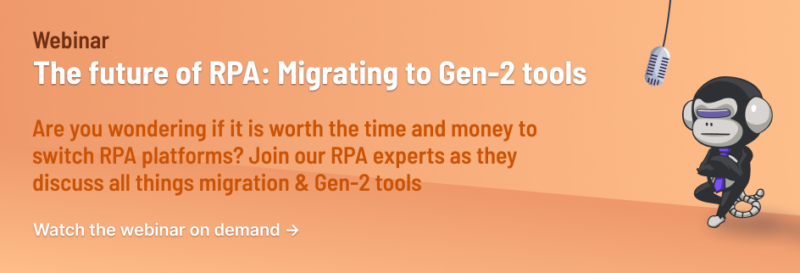Migrating to a Gen2 RPA Platform
What is Gen2 RPA, and how does it compare to Gen1? Discover the benefits, weighing the risks and rewards, the models of bot migration, and more.

RPA and Automation Migration
By now, you know about the power of Robotic Process Automation (RPA), and maybe you’ve even picked out some tasks within your organization’s day-to-day work that could benefit from automation. While RPA comes with the promise that you can save time and money by automating repetitive tasks, RPA does have some limitations—especially with the first generation tools (henceforth known as Gen1). This is where the second generation (Gen2) of RPA comes in, with organizations exploring and migrating to Gen2.
What is second generation (Gen2) RPA?
Simply put, Gen2 RPA tools offer new pricing structures, more flexibility, and better integrations than Gen1. Gen1 platforms mostly allow users to automate monotonous tasks that deal with defined inputs—most often the UI.
Want to learn more about migrating to Gen2? Click here to watch Robocorp’s Gen2 RPA webinar on-demand:

Who are the Gen2 RPA players?
There are a handful of established companies and startups in the Gen2 space, including Robocorp. Such Gen2 players change the process automation game in a number of ways such as increasing the number of layers at which automation is possible, simplified frameworks, multiple integration capabilities and more.
With Robocorp’s Python-based RPA platform, developers can build automations in such a way that meet their company’s exact needs and connect the platforms they already use. So while there are numerous startups in the Gen2 provider space Robocorp feels confident that we are the most enterprise-ready players out there, having recently raised $21 million in a Series A funding and completing the SOC 2 certification.
This means that our technology is enterprise-ready, and our partners and customers can be certain that Robocorp offers secure data processing and storage, and safe environments.
What’s the role of open source in Gen2 RPA?
First, using open source RPA saves you from expensive vendor lock since you can build and own your bots. You don’t have to be constrained by the commercial vendor’s capabilities either. Secondly, with tools, documentation and support available to the general public, different minds within the developer community can contribute to the libraries, keywords, and sample robots that others can use.
More importantly, open source RPA enables people at different points in the learning and adoption curve to experiment with automation securely and in a cost-efficient manner. Open source RPA tools are also easily customizable and give organization’s more flexibility when it comes to frequency of usage vs. service contract length.
Exploring what’s possible with Gen2 RPA
Gen2 platforms come with a number of direct and indirect benefits that Gen1 platforms don’t have:
Technical capabilities
Most Gen1 RPA platforms perform automation at the Graphical User Interface (GUI) level, which makes it harder for the robots to interact with web applications. Gen2 RPA platforms enable automation at numerous levels, meaning that you’re not limited to automating only the actions that are made by a person interacting with the GUI.
Gen1 tools weren’t built with artificial intelligence and machine learning in mind. However, Gen2 tools are designed to be able to harness these technologies, allowing you to create bots that can learn continuously. This makes Gen2 tools better for dynamic scenarios where desired outcomes can change due to variable inputs.
Cost structures
Gen1 providers often have outdated licensing models with fixed rates that can leave organizations wasting resources when they don’t use all the available features. In contrast, Gen2 providers have more favorable pricing models, with tiers, and even consumption-based pricing from providers like Robocorp. They also give you a chance to start for free and gradually figure out what you’ll need to pay for.
Gen2 platforms also widen the scope of what you can do via the cloud, which subsequently reduces infrastructural costs.
Weighing the risk and reward
Migrating to a Gen2 platform may sound like a heavy lift, and there is always the element of the unknown when implementing new technology. So let’s understand why some organizations may be reluctant to migrate to a new technology.
- Switching to Gen2 can be quite expensive since you may not have a clear picture of your additional needs in comparison to what various Gen2 providers can offer.
- Bot migration isn’t always seamless. There might be a need to rebuild bots or make some tweaks to them, a process that can have a bit of trial and error.
- There’s a possibility of experiencing downtime during the migration, with some occasional issues afterwards too.
Migrating to Gen2 RPA tools
RPA migration can happen in a number of ways including:
Full migration. This is a model where the organization switches entirely from one vendor to another. All automations are moved too.
Supplementary/Dual vendor. In this case, an organization chooses to retain some of the automations that are working fine in Gen1 tools, especially the UI-based automations. But since they have some more complex needs such as web- or API-based automations, they seek out a Gen2 provider like Robocorp for those particular needs.
How migration happens
There are a couple of steps involved in RPA migration, and these include:
Planning process
This step is largely about mapping automations and ascertaining what’s possible. You need to look at the existing automations, the additional complex processes, and the gap between them. Planning helps to know what will more or less be left intact, what will be adjusted, and what will be entirely rebuilt.
Bot conversions
This part is about understanding the model of the existing bots and how it differs from the target model of the new RPA platform. The bots are then optimized to work with the new tool, and in some cases, reverse engineering is applied.
Regardless of the stage at which you are in your RPA journey, it is always good to keep an eye on the latest developments in this space. If you are looking for an RPA solution that speaks to your organization’s troubles, the quest might seem challenging.
However, figuring out how best to balance expenditure with efficiency-boosting technical capabilities can be made easier by reaching out to the team a Robocorp. We are determined to offer the most effective and affordable solution.